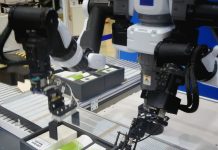HMI stands for Human Machine Interface. This article provides details about HMI, its uses, importance in industrial automation, and differences with SCADA.
Introduction to HMI
HMI is typically used in the industrial automation sector in applications that leverage remote monitoring to manage the process parameters. To start, HMI is a software or device that is utilized for communicating with groups of machines or a single machine in the production area or plant.
The system directly connects humans with machines by translating the high volume of complex information into accessible data through its monitor’s graphical representation. This gives the operator all the needed tools and features to manage the process.
HMI is also termed Operator Terminal (OT), Local Operator Interface (LOI), Operator Interface Terminal (OIT), or Man-Machine Interface (MMI).
Utilization in Industrial Automation
HMI is chiefly used to visualize alarms, trends, etc., and visualize, control, and monitor the plant process. This device is rendered in the form of an inbuilt screen on tablets, computers, machines, and other devices. Its purpose is to help humans interact with machines.
The HMI’s screen displays useful information such as alarms, machine fault status, machine running status, flow, temperature, pressure, and others. This data helps the operator to track the equipment status and operate it.
You can monitor or control a small industrial site or plant leveraging a single centrally placed HMI. Plus, you can connect multiple HMIs in parallel with one PLC to make it simple to troubleshoot issues; however, you must do so under an expert’s supervision.
How Does It Work?
A PLC (programmable logic controller) is utilized to manage the process through sequential user control logic. The PLC initially reads the input statistics then processes it as per the installed logic. Next, it activates outputs like contactor, coils, relays, etc. through signals from the output card. The PLC displays all this data in a simple-to-understand graphical format.
A user with access to the relevant software can alter the PLC system’s logic and view the input and output data by placing the PLC online. But this method may not be suitable for all users who wish to track the control logic and input and output information. To represent all this data, specific software is needed, which can link with PLC memory and show all the essential information without allowing unauthorized users to access and modify or change the PLC logic.
HMI is a type of device which can link with PLC on a network and provides all process parameters data and input and output stats without compromising PLC security. The HMI may be a particular purpose or general-purpose computer screen. Most industrial HMIs come with touch screens that enable users to operate them efficiently. Electrical professionals can program the HMI suitably so operators can understand the sensor and machine status.
SCADA vs. HMI
- SCADA (Supervisory Control and Data Acquisition) is similar to HMI, but the former has a few added functions that make it different from the latter.
- SCADA cannot be a part of HMI, but HMI can be included in SCADA.
- HMI is typically installed in the field close to the equipment, whereas SCADA is usually placed at the plant’s center where a user can control or monitor the equipment in the entire plant.
- Both SCADA and HMI are utilized to represent plant data in a graphical interface. SCADA also collects data or has a database to capture historical information. But HMI does not have the capability to maintain a database or record data.
It’s a smart idea to consult licensed professionals to get their input on ideal electrical systems for your business needs. Such critically electrical systems require expert guidance and back-up for installation and maintenance, so you must seek help from a certified professional.







